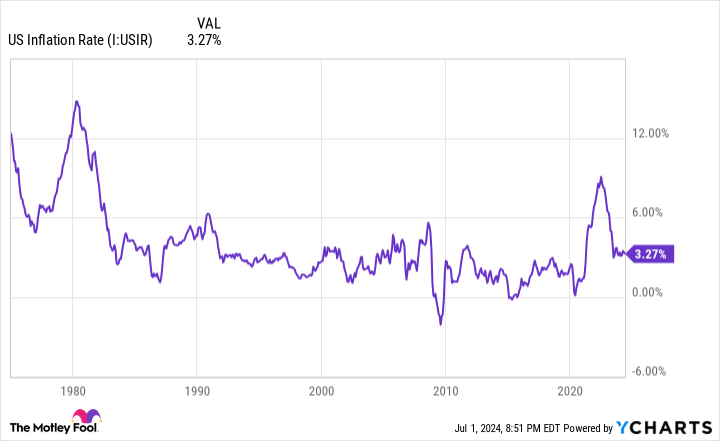For most retired Americans, Social Security isn’t just a check they receive each month. Rather, it represents a vital source of income that many would struggle to live without.
Even though the average payout in May was only $1,916.63 for Social Security’s roughly 51 million retired-worker beneficiaries, a whopping 88% of surveyed retirees in Gallup’s 2024 poll responded that their Social Security benefit comprises a “major” or “minor” part of their income. In other words, nearly nine out of 10 current retirees lean on America’s leading social program to make ends meet.
Given how reliant existing retirees are on Social Security income, it should come as no surprise that one of the most anticipated reveals of the year is the cost-of-living adjustment (COLA) announcement during the second week of October.
Unfortunately, this year’s COLA reveal is shaping up as a lose-lose for retirees.

What is Social Security’s cost-of-living adjustment (COLA), and why is it so important?
In simple terms, Social Security’s “COLA” is the mechanism that allows the program to account for price changes in a broad basket of goods and services. We refer to these changes as inflation (rising prices) or deflation (falling prices).
For example, if a variety of goods and services that seniors regularly purchase increases in price, Social Security checks should, in a perfect world, rise by the same percentage to ensure that beneficiaries don’t lose purchasing power. Social Security’s COLA is this tracking tool that aims to keep benefits on par with inflation.
In Social Security’s early days (1940-1974), benefit hikes were passed along arbitrarily by special sessions of Congress. After no COLAs were doled out during the entirety of the 1940s, 11 total benefit adjustments were passed along between 1950 and 1974.
Beginning in 1975, the Consumer Price Index for Urban Wage Earners and Clerical Workers (CPI-W) became the standard measure of inflation for Social Security, which allowed for COLAs to be passed along on an annual basis. The CPI-W has more than half a dozen major spending categories and far more subcategories, all of which have their own respective weightings. These weightings are what allow the CPI-W to be chiseled down to a single figure each month, which makes it easy to tell if inflation or deflation has taken hold.
To calculate Social Security’s cost-of-living adjustment, trailing 12-month (TTM) CPI-W readings from the third quarter (July through September) of the current year are compared to TTM readings from the comparable period in the previous year. If the average third-quarter CPI-W reading is higher in the current year than in the previous year, inflation has occurred and beneficiaries will receive a larger benefit in the upcoming year.
The magnitude of this “raise” is determined by the year-over-year percentage increase in average third-quarter CPI-W readings, rounded to the nearest tenth of a percent. It’s that simple.
What’s in store for Social Security’s 2025 COLA?
Although the TTM CPI-W readings from the other nine months of the year aren’t factored into the COLA calculation, they do offer plenty of clues as to what the future may hold.
In each of the three previous years, Social Security’s cost-of-living adjustment has come in well ahead of the two-decade average of 2.6%. For 2022, 2023, and 2024, program recipients saw their respective Social Security checks increase by 5.9%, 8.7%, and 3.2%. It should be noted that the 8.7% increase for 2023 was the largest “raise” for beneficiaries in 41 years!
Based on data from the U.S. Bureau of Labor Statistics’ (BLS) May inflation report, estimates for the 2025 COLA are at, or slightly above, the two-decade average.
Nonpartisan senior advocacy group The Senior Citizens League (TSCL) slightly reduced its forecast for Social Security’s 2025 COLA to 2.57% (which would round to 2.6%) from 2.66% following the release of the May inflation report.
Meanwhile, independent Social Security and Medicare policy analyst Mary Johnson, who had previously worked with TSCL prior to her retirement, reduced her estimate for next year’s COLA to 3% from 3.2% after the BLS inflation report for May.
Though cost-of-living adjustments vary a bit, a 2.6% to 3% COLA — should these estimates prove accurate — would result in the average retired-worker beneficiary taking home $50 to $57 more per month in 2025.
Additionally, a Social Security COLA of 2.6% to 3% would result in a monthly benefit increase of $40 to $46 for workers with disabilities, and a $39 to $45 monthly boost for survivor beneficiaries.

A lose-lose scenario likely awaits Social Security’s seniors in 2025
Statistically, it’s been 28 years since Social Security’s COLA has come in at or above 2.6% for four consecutive years. On a nominal dollar basis, an estimated COLA ranging from 2.6% to 3% in 2025 would appear to be a win for retirees. However, looks can be deceiving.
Following slightly cooler-than-expected core inflation in May — core inflation removes food and energy costs from the equation — COLA estimates from TSCL and Mary Johnson declined modestly. If this cooling pattern were to persist, the expected cost-of-living adjustment for 2025 would likely taper.
The issue for seniors is that they’ve been dealing with subpar COLAs throughout much of the century. In May 2023, TSCL issued a report that compared aggregate Social Security COLAs between January 2000 and February 2023 to the change in price for a basket of dozens of goods and services purchased by the typical retiree over the same timeline. Whereas Social Security’s cost-of-living adjustments had risen by an aggregate of 78%, the basket of goods and services had jumped by 141.4%! The end result has been a 36% loss of purchasing power for Social Security income since 2000.
But here’s the kicker: Seniors are probably also going to lose if Social Security’s 2025 COLA comes in ahead of expectations.
If inflation reaccelerates between July and September and pushes the 2025 cost-of-living adjustment higher, two specific expenses are liable to be the culprits: Shelter and medical care services. Shelter accounts for rent or owners’ equivalent rent and is the single largest weighting in the CPI-W.
Though a higher COLA would increase Social Security checks for seniors, the two major expenses that retirees spend a larger percentage of their budget on, when compared to the average working American, are (drumroll)… shelter and medical care services. Stubbornly high shelter expenses, and reaccelerating medical care costs, are almost certain to more than offset any COLA that seniors receive in the upcoming year.
The way things are shaping up, Social Security’s 2025 COLA will result in yet another year of retirees losing purchasing power.
The $22,924 Social Security bonus most retirees completely overlook
If you’re like most Americans, you’re a few years (or more) behind on your retirement savings. But a handful of little-known “Social Security secrets” could help ensure a boost in your retirement income. For example: one easy trick could pay you as much as $22,924 more… each year! Once you learn how to maximize your Social Security benefits, we think you could retire confidently with the peace of mind we’re all after. Simply click here to discover how to learn more about these strategies.
View the “Social Security secrets” ›
The Motley Fool has a disclosure policy.
Social Security’s 2025 Cost-of-Living Adjustment (COLA) Is Shaping Up to Be a Lose-Lose Scenario for Retirees was originally published by The Motley Fool
EMEA Tribune is not involved in this news article, it is taken from our partners and or from the News Agencies. Copyright and Credit go to the News Agencies, email news@emeatribune.com Follow our WhatsApp verified Channel






